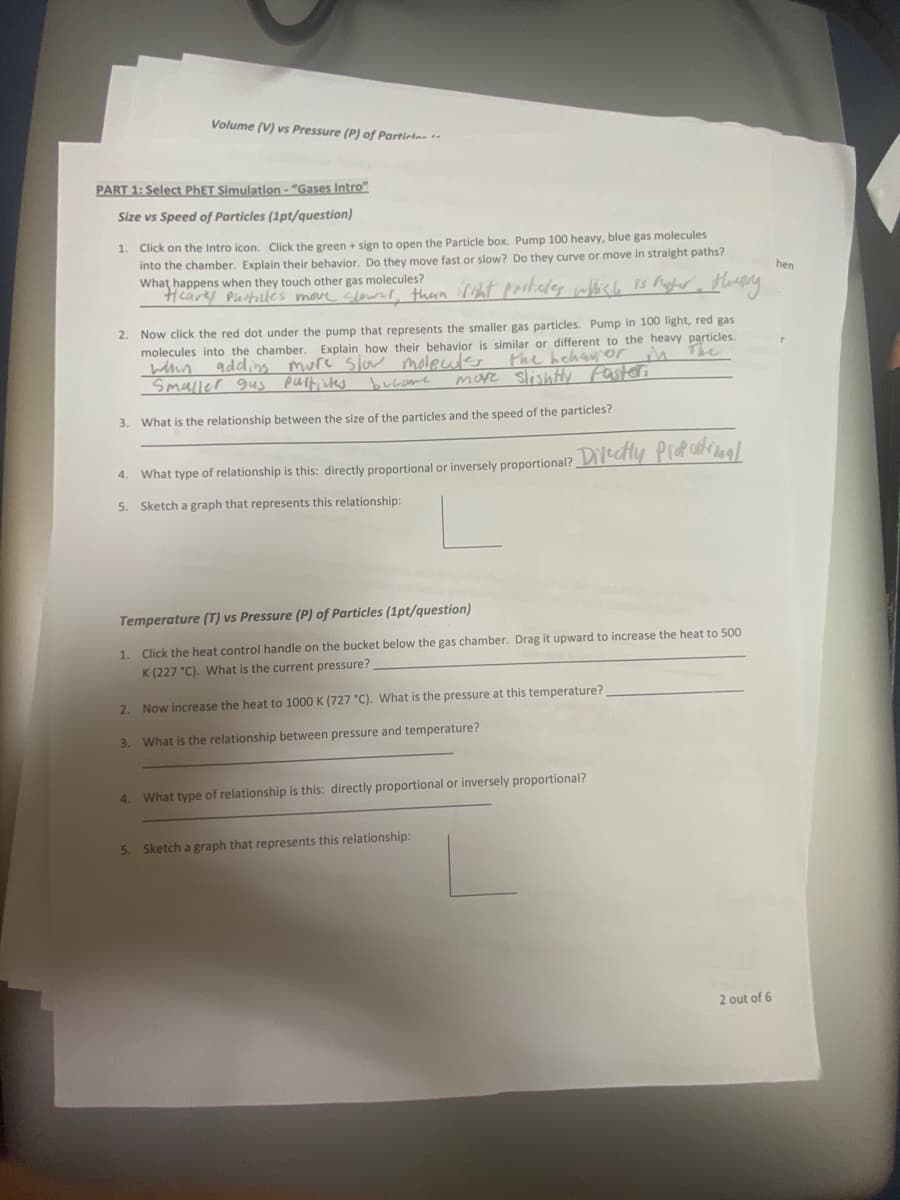PART 1: Select PHET Simulation - "Gases Intro". Size vs Speed of Particles (1pt/question) 1. Click on the Intro icon. Click the green + sign to open the Particle box. Pump 100 heavy, blue gas molecules into the chamber. Explain their behavior. Do they move fast or slow? Do they curve or move in straight paths? What happens when they touch other gas molecules? Heares Puitilles move clower, theun riht partiedes bich s Meter, Mng hen
PART 1: Select PHET Simulation - "Gases Intro". Size vs Speed of Particles (1pt/question) 1. Click on the Intro icon. Click the green + sign to open the Particle box. Pump 100 heavy, blue gas molecules into the chamber. Explain their behavior. Do they move fast or slow? Do they curve or move in straight paths? What happens when they touch other gas molecules? Heares Puitilles move clower, theun riht partiedes bich s Meter, Mng hen
Biology: The Dynamic Science (MindTap Course List)
4th Edition
ISBN:9781305389892
Author:Peter J. Russell, Paul E. Hertz, Beverly McMillan
Publisher:Peter J. Russell, Paul E. Hertz, Beverly McMillan
Chapter46: Gas Exchange: The Respiratory System
Section: Chapter Questions
Problem 8TYK: Oxygen enters the blood in the lungs because relative to alveolar air: a. the CO2 concentration in...
Related questions
Question
I need those answers

Transcribed Image Text:Volume (V) vs Pressure (P) of Particles t-
PART 1: Select PHET Simulation - "Gases Intro"
Size vs Speed of Particles (1pt/question)
1. Click on the Intro icon. Click the green + sign to open the Particle box. Pump 100 heavy, blue gas molecules
into the chamber. Explain their behavior. Do they move fast or slow? Do they curve or move in straight paths?
What happens when they touch other gas molecules?
Heares Purticles move clowrl, thun riht porticdes which 1s gter Huy
hen
2. Now click the red dot under the pump that represents the smaller gas particles. Pump in 100 light, red gas
molecules into the chamber. Explain how their behavior is similar or different to the heavy particles.
whin
Smaller gus
adding mure' slow moleuls the hehan or
more Slishty fasteri
put, ues
bucame
3. What is the relationship between the size of the particles and the speed of the particles?
What type of relationship is this: directly proportional or inversely proportional? Decly Profaaal
4.
5. Sketch a graph that represents this relationship:
Temperature (T) vs Pressure (P) of Particles (1pt/question)
1.
Click the heat control handle on the bucket below the gas chamber. Drag it upward to increase the heat to 500
K (227 "C). What is the current pressure?
2.
Now increase the heat to 1000 K (727 °C). What is the pressure at this temperature?
3. What is the relationship between pressure and temperature?
4. What type of relationship is this: directly proportional or inversely proportional?
5.
Sketch a graph that represents this relationship:
2 out of 6
Expert Solution
This question has been solved!
Explore an expertly crafted, step-by-step solution for a thorough understanding of key concepts.
This is a popular solution!
Trending now
This is a popular solution!
Step by step
Solved in 3 steps with 2 images

Knowledge Booster
Learn more about
Need a deep-dive on the concept behind this application? Look no further. Learn more about this topic, biology and related others by exploring similar questions and additional content below.Recommended textbooks for you

Biology: The Dynamic Science (MindTap Course List)
Biology
ISBN:
9781305389892
Author:
Peter J. Russell, Paul E. Hertz, Beverly McMillan
Publisher:
Cengage Learning

Anatomy & Physiology
Biology
ISBN:
9781938168130
Author:
Kelly A. Young, James A. Wise, Peter DeSaix, Dean H. Kruse, Brandon Poe, Eddie Johnson, Jody E. Johnson, Oksana Korol, J. Gordon Betts, Mark Womble
Publisher:
OpenStax College

Cardiopulmonary Anatomy & Physiology
Biology
ISBN:
9781337794909
Author:
Des Jardins, Terry.
Publisher:
Cengage Learning,

Biology: The Dynamic Science (MindTap Course List)
Biology
ISBN:
9781305389892
Author:
Peter J. Russell, Paul E. Hertz, Beverly McMillan
Publisher:
Cengage Learning

Anatomy & Physiology
Biology
ISBN:
9781938168130
Author:
Kelly A. Young, James A. Wise, Peter DeSaix, Dean H. Kruse, Brandon Poe, Eddie Johnson, Jody E. Johnson, Oksana Korol, J. Gordon Betts, Mark Womble
Publisher:
OpenStax College

Cardiopulmonary Anatomy & Physiology
Biology
ISBN:
9781337794909
Author:
Des Jardins, Terry.
Publisher:
Cengage Learning,

Biology: The Unity and Diversity of Life (MindTap…
Biology
ISBN:
9781337408332
Author:
Cecie Starr, Ralph Taggart, Christine Evers, Lisa Starr
Publisher:
Cengage Learning

Biology: The Unity and Diversity of Life (MindTap…
Biology
ISBN:
9781305073951
Author:
Cecie Starr, Ralph Taggart, Christine Evers, Lisa Starr
Publisher:
Cengage Learning
